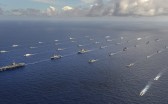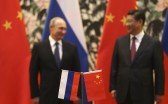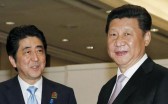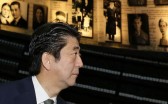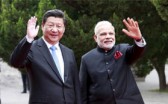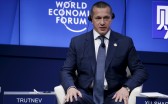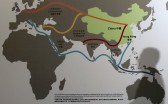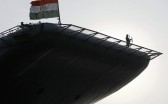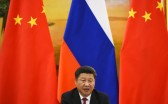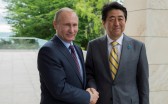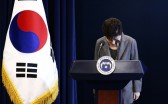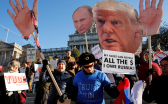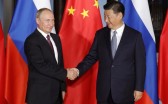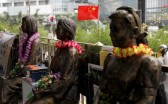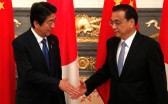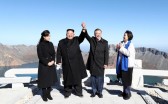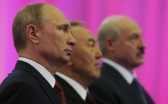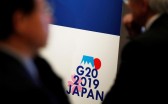Beijing’s initiative, the Silk Road Economic Belt (SREB), is meant to contribute to China’s economic rise by creating markets for surplus production of such goods as steel and cement, putting Chinese companies to work building infrastructure, and integrating China’s economy with its periphery. It also was meant to develop comprehensive relations with countries along the SREB in Central Asia, South Asia, West Asia, the Middle East, and Eastern Europe, broadly defined as Eurasia. Russian rejuvenation depends on Vladimir Putin’s Eurasian Economic Union (EEU) initiative, which officially came into existence on January 1, 2015. It is an economic union to create an integrated single market. Putin believes that the EEU is absolutely necessary to restore Russian greatness and influence in the "near abroad," which will then restore Russia as a great power in the world and that development of its Far East is essential for rejuvenation. Xi and Putin agreed to integrate their initiatives—a new impulse for cross-border cooperation.
Whether these two initiatives are compatible may depend on reconciling differing concepts of the economic and physical integration of China’s Northeast and Russia’s Far East (Dongbei-RFE integration). Dongbei is the industrial rust belt of China with unemployed and unpaid workers, and slowing economic growth on a scale that stands out across China. The RFE is a region that has been used by Moscow as a raw materials base with insufficient investment in its industrialization—a problem that Putin has found increasingly troubling. Chinese speak of raw materials as Russia’s comparative advantage, while Russians reject this. In the 1990s, Sino-Russian bilateral border trade, driven by small-scale trade and shuttle traders, contributed to Heilongjiang’s economic growth. In 2004, Beijing launched the “Revive the Northeast” initiative, due to Heilongjiang’s lobbying, which included plans to export to the RFE. Trade with Russia skyrocketed, but Russia was not satisfied that it largely consisted of energy and raw material exports, while Heilongjiang has continued to see the RFE as a market for its industrial exports and key to its economic growth. With energy prices depressed, Russia is even more eager to find a new model for the development of its Far East, while China is newly intent on linking the Northeast to Russian regions. Are the two sides finding common ground?
Heilongjiang is eager to participate in SREB not so much linked to Central Asia as heavily based on integration with the RFE. The Chinese map of “One Belt, One Road,” as it is now drawn, links the RFE with Mongolia and, beyond, Central Asia. If Vladivostok had hoped to integrate with the Asia-Pacific and to cultivate a “Pacific Russia” identity, that is not in the “One Belt, One Road” plan. In fact, it would be discouraged if it pulled the RFE away from China’s orbit. Russia has in mind multilateral linkages, while China is pressing for greater bilateral integration where the proximity of the two countries is greatest and it anticipates a clear payoff from infrastructure investments and economic complementarities rather different from Russia’s aspirations. Even so, the emphasis on both sides is coordination, not rivalry.
Infrastructure projects are beginning to intensify Dongbei-RFE physical linkages. People’s Daily on May 12, 2016, announced planning had started for a high-speed railway linking China’s Hunchun, on the Tumen River, with Russia’s Vladivostok. This will be important infrastructure enabling realization of Dongbei-RFE economic and physical integration. A long delayed railroad bridge is finally being constructed across the Amur River between Heihe and Blagoveshchensk. Russia’s East Siberia-Pacific Ocean (ESPO) oil pipeline has a spur at Skorovodino that moves oil to China’s Daqing. Such infrastructure building assumes the existence of a natural economic territory that spans the Sino-Russian border between Heilongjiang and the RFE. Chinese have long claimed that China’s Northeast and Russia’s Far East form a natural economic territory that has a long history, if at times disrupted by political borders. It is assumed that a natural economic territory with commercial exchange existed prior to the formation of nation-state borders.
Chinese have touted for this territory an international division of labor based on “comparative advantage”—China is a supplier of labor and industrial goods and Russia is a supplier of raw materials. This is their respective comparative advantage, but this idea of Russia’s comparative advantage within a natural economic territory and Russian ideas of resurgence are incompatible. When Chinese first spoke of the Dongbei-RFE natural economic territory in the late 1980s, the international division of labor was: China supplied labor, Japan supplied investment, and Russia supplied raw materials. Twenty-five years later, China has supplanted Japan as a source of investment capital. Chinese workers have long been employed in farming and construction in the RFE, but the numbers fall far short of the hyperbolic alarm at times aroused in Russia. For economic plans to succeed, it is widely assumed that those numbers will have to rise substantially—still a source of concern on the Russian side. Russia is more intent on China supplying the investments and more tolerant of China supplying some of the labor, but it is also resistant to the notion of the RFE as just a source of raw materials for Chinese industrialization. It does not fit with the identity of a “resurgent Russia” reestablishing itself as a great power. Russians want Chinese investment to be focused on industrial production that will contribute to Russia’s resurgence, while also hesitating about a large influx of Chinese labor.
A recent (2015) Chinese history on the RFE, intent on discursively incorporating the RFE into the SREB, has reconstructed the RFE’s identity as a region situated on the Northeast Asian frontier of Eurasia. This history shrinks the time frame of Russian residence in the RFE and situates it in a Chinese dynastic history with transregional exchanges at a time that lacked borders. The narrative credits transboundary exchanges in the early twentieth century as the driver of economic growth. It is a constructed historical narrative suitable for supporting the logic of Dongbei-RFE integration.1 This is not a comforting narrative for Russians who fear that loss of barriers to China economically would be a precursor to social and political integration too.
Russian resistance has not deterred Chinese planning. In March 2015, the Chinese Foreign Ministry issued Vision and Actions on Jointly Building Silk Road Economic Belt and 21st-Century Maritime Silk Road. The RFE was included in SREB’s action plan, in cooperation with Heilongjiang, Jilin, and Liaoning in transportation networks on land and sea. It was presented as a fait accompli that Dongbei-RFE economic integration would be incorporated into the SREB. The SREB and the EEU were formally linked during the May 8-9, 2015 visit by Xi Jinping to Moscow. Moscow and Beijing also agreed to link SREB with the RFE Development Program. However, a year later, Chinese and Russians are still contemplating how to link these two, still rather amorphous projects SREB and EEU. Linking the RFE to the SREB is less abstract because it builds on years of discussing Dongbei-RFE integration.
Moscow’s expectation of Chinese investment is to supply capital and technology for the RFE, building industrial capacity for exported manufactures to markets in East Asia. Russia hosted the 2012 Asia-Pacific Economic Cooperation (APEC) forum in Vladivostok hoping to attract foreign investment to the city from all over the Asia-Pacific. The first Eastern Economic Forum (EEF) in Vladivostok, September 3-5, 2015, was meant to attract investors to priority projects in the RFE. It is Moscow’s hope that Chinese investment will finance RFE development. The EEF was followed by the First Meeting of Regional Cooperation Council of Northeast China and Russian Far East, chaired by Vice Premier Wang Yang and Deputy Prime Minister and Presidential Plenipotentiary Envoy to the Far Eastern Federal District, Yury Trutnev. The meeting demonstrated that Dongbei-RFE integration would be state-led and top-down. It was not yet clear, however, which side’s notion of how to achieve integration would prevail, especially given the low commodity prices and the low level of Chinese investment that has followed the high-sounding plans of 2014 and 2015.
Twenty-five years ago, Heilongjiang hoped the Tumen River Area Development Program, now called the Greater Tumen Initiative, would facilitate Dongbei-RFE economic integration. However, Tumen faced stiff resistance from local Russians in the Russian Far East. Chinese specialists still believe that Tumen had potential if only there had not been local Russian opposition in the 1990s. They believe Tumen could still be successful if China’s Northeast could be integrated with the RFE, which may leave the role of North Korea vague.
In October 2009, Premier Wen Jiabao had proposed regional economic integration of the RFE and Chinese Northeast, as a side agreement of the Sino-Russian negotiations over ESPO. Called the Program of Cooperation between the Northeast of the People’s Republic of China and the Far East and Eastern Siberia of the Russian Federation (2009-2018), the regional integration agreement received less attention than the oil pipeline. There were several Chinese publications that were published before and after the pipeline agreement was signed. Most of these publications assume Russia’s comparative advantage is raw materials. In 2009, one Russia specialist, Lu Nanquan, published Research Issues on Promoting Regional Economic and Trade Cooperation between China and Russia,2 and participated in a symposium on RFE energy development and China’s interaction and cooperation: Sino-Russian International Regional Cooperation and Development. It covered oil and gas cooperation and ways to deepen regional cross-border economic integration.3 Others explored the feasibility of a free trade zone along the border.4 Yet, Russia failed to implement more than 200 projects in the 2009 agreement on Dongbei-RFE economic integration, which continued to exist only on paper, ceased functioning before completion, and caused Chinese economic losses. Chinese are disappointed with the 2009 agreement and suspect this might be a pattern that will be repeated by Russia in the SREB, blocking or delaying projects. In 2015, Chinese specialists noted that the Dongbei-RFE initiative had been incorporated into China’s SREB and that integration would contribute to China’s rise and globalization.5 There was no discussion whether it would contribute to Russia’s rejuvenation.
Although there has been limited progress in implementation, it has been a continuous act of faith by the Chinese over several decades that “China’s drive to rejuvenate its northeastern industrial bases tallies favorably with Russia’s eastern Siberia and Far East development strategy.”6 The change in 2015 was the framing of this border integration as part of a larger joining of regional schemes—SREB with the EEU centered on Central Asia. Chinese persist with ideas of comparative advantage, creating a conceptual hurdle that impedes further cooperation. Russians have never accepted the logic of comparative advantage in Dongbei-RFE economic relations because it situates the RFE as a source of raw materials for Chinese industrialization. It is possible that numerous infrastructure projects will facilitate Dongbei-RFE integration, but there is still not a meeting of the minds.
1. Nianshen Song, "Northeast Eurasia as Historical Center: Exploration of a Joint Frontier," The Asia- Pacific Journal 13, no. 1 (November 2, 2015).
2. 陆南泉, 推进中俄区域经贸合作若干问题的研究, 黑龙江社会科学, no. 1, 2009.
3. 朱显平, 陆南泉, 俄罗斯东部及能源开发与中国的互动合作:中俄国际区域合作与发展学术研讨会论 (Changchun: Changchun chubanshe, 2009).
4. 赵传君, 创建中俄自由贸易区问题探索 (Beijing: Shehuikexue wenxian chubanshe, 2010).
5. Zhang Keyun and Cai Zhibing, “Globalization 4.0, Regional Coordinated Development 4.0, and Industry 4.0: The background to the ‘One Belt, One Road’ strategy and its intrinsic nature and critical power,” ERINA Report, no. 127 (December 2015), http://www.erina.or.jp/wp-content/uploads/2015/02/se12719_tssc.pdf.
6. Li Xin, “Silk Road can find common ground with Eurasian Economic Union,”
Global Times, April 26, 2015.
